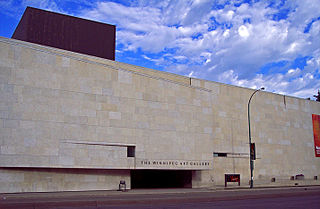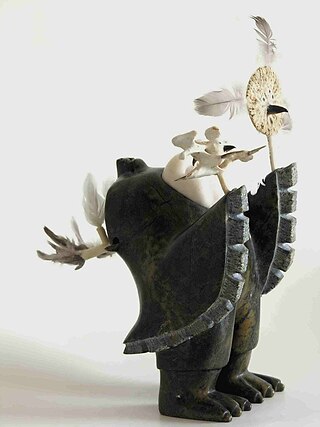Related Research Articles

The Winnipeg Art Gallery (WAG) is an art museum in Winnipeg, Manitoba, Canada. Its permanent collection includes over 24,000 works from Canadian, Indigenous Canadian, and international artists. The museum also holds the world's largest collection of Inuit art. In addition to exhibits for its collection, the museum has organized and hosted a number of travelling arts exhibitions. Its building complex consists of a main building that includes 11,000 square metres (120,000 sq ft) of indoor space and the adjacent 3,700-square-metre (40,000 sq ft) Qaumajuq building.

Jessie Oonark, was a prolific and influential Inuit artist of the Utkuhihalingmiut Utkuhiksalingmiut whose wall hangings, prints and drawings are in major collections including the National Gallery of Canada.

Inuit art, also known as Eskimo art, refers to artwork produced by Inuit, that is, the people of the Arctic previously known as Eskimos, a term that is now often considered offensive. Historically, their preferred medium was walrus ivory, but since the establishment of southern markets for Inuit art in 1945, prints and figurative works carved in relatively soft stone such as soapstone, serpentinite, or argillite have also become popular.
Ningiukulu (Ningeokuluk) Teevee is a Canadian Inuit writer and visual artist.
KC Adams is a Cree, Ojibway, and British artist and educator based in Winnipeg, Manitoba.
Agnes Nanogak Goose was an Inuk artist from Holman (Ulukhaktok), Northwest Territories, Canada.

Janet Kigusiuq was an Inuit artist. Kigusiuq came from a large family of artists: she was the eldest daughter of Jessie Oonark, her siblings included artists Victoria Mamnguqsualuk, Nancy Pukingrnak, Peggy Qablunaaq Aittauq, Mary Yuusipik Singaqti, Josiah Nuilaalik, Miriam Marealik Qiyuk, and William Noah, and she was married to Mark Uqayuittuq, son of Luke Anguhadluq, themselves both artists.
Pitaloosie Saila was a Canadian Inuk graphic artist who predominantly made drawings and lithograph prints. Saila's work often explores themes such as family, shamanism, birds, and her personal life experiences as an Inuk woman. Her work has been displayed in over 150 exhibitions nationally and internationally, such as in the acclaimed Isumavut exhibition called "The Artistic Expression of Nine Cape Dorset Women". In 2004, Pitaloosie Saila and her well-known husband and sculptor Pauta Saila were both inducted into the Royal Canadian Academy of Arts.
Aganetha Dyck is a Canadian sculptor residing in Winnipeg, Manitoba. Dyck is best known for her work with live honeybees, that build honeycomb on objects that she introduces to honeybee hives. In 2007 Dyck was awarded both Manitoba's Arts Award of Distinction and Canada's Governor General's Award in Visual and Media Arts.
Diana Thorneycroft is a Canadian artist based in Winnipeg, Manitoba, whose work has exhibited nationally and internationally. She works primarily in photography, drawing, and sculpture/installation and makes photographs of staged dioramas to explore sexuality and national identity, and even, national icons such as the Group of Seven. Her work blurs the lines between gendered bodies by employing phalluses. She is also an educator: she worked as a sessional instructor at the University of Manitoba's School of Art for 25 years.

Ulayu Pingwartok was a Canadian Inuk artist known for drawings of domestic scenes and nature.
Alison Houston Lockerbie Newton (1890–1967) was a Canadian painter known for her watercolours and woodblock prints.
Eleeshushe Parr was an Inuk graphic artist and sculptor, from the Kingnait area, who produced over 1,160 drawings. Her work has been exhibited in Canada, the United States, and Sweden.
Egevadluq Ragee (1920–1983) was a Canadian artist, known primarily for her hand drawn prints and acrylics.
Elisapee Ishulutaq was a self-taught Inuit artist, specialising in drawing and printmaking. Ishulutaq participated in the rise of print and tapestry making in Pangnirtung and was a co-founder of the Uqqurmiut Centre for Arts & Crafts, which is both an economic and cultural mainstay in Pangnirtung. Ishulutaq was also a community elder in the town of Pangnirtung. Ishulutaq's work has been shown in numerous institutions, including the Marion Scott Gallery in Vancouver, the Winnipeg Art Gallery and the National Gallery of Canada.

Mary Kapbak Okheena is an Inuvialuit graphic artist known for her stencil prints including "Musk-ox Waiting for the Tide to Cross Water" (1986) and "Shaman Dances to Northern Lights" (1991), drawings and embroidery. She is part of the third generation of organized graphic artists in the Canadian Arctic. Okheena has five children with her husband Eddie and she currently lives in Inuvik where she practices embroidery and makes wall hangings.
Mayureak Ashoona is an Inuit artist, known for her works on paper.
The West Baffin Eskimo Cooperative, also known as the Kinngait Co-operative is an Inuit co-operative in Kinngait, Nunavut best known for its activities in buying, producing and selling Inuit artworks. The co-operative is part of Arctic Co-operatives Limited, a group of locally owned businesses that provide fundamental services in the Canadian north. The co-operative sets prices for the sale of its member's works, pays the artists in advance and shares its profits with its members.

Kiakshuk was a Canadian Inuit artist who worked both in sculpture and printmaking. Kiakshuk began printmaking in his seventies and, is most commonly praised for creating “real Eskimo pictures” that relate traditional Inuit life and mythology.
Jack Butler is an American-Canadian visual artist. His work is in public and private collections including the National Gallery of Canada. He is a founding member of Sanavik Inuit Cooperative, Baker Lake, Nunavut. He is a medical model builder and published researcher in human development. He taught at Carnegie Mellon University, at the Banff Centre, the University of Manitoba, and in the Department of Philosophy at the University of Western Ontario.
References
- ↑ "Canadian Art Winnipeg". Winnipeg Art Gallery . Retrieved 2016-03-05.
- 1 2 3 "art and cold cash". University of Western Ontario . Retrieved 2016-03-05.
- 1 2 "Sheila Butler". Galerie Q. Retrieved 2016-03-05.
- ↑ "Volumes 28-29". Fuse Magazine . Arton's Cultural Affairs Society and Publishing. 2005. Retrieved 2016-03-05.
- ↑ Gary Michael Dault (15 April 2008). "A show with drawing power". The Globe and Mail . Retrieved 2016-03-05.
- 1 2 3 4 5 6 Jules Heller, Nancy G. Heller (2013). North American Women Artists of the Twentieth Century: A Biographical Dictionary. Routledge. ISBN 978-1135638894 . Retrieved 2016-03-05.
- ↑ Jackson, Marion Elizabeth. Baker Lake Inuit Drawings: A Study in the Evolution of Artistic Self-Consciousness. Michigan, MI: University of Michigan, 1985. Print. OCLC 54855662
- ↑ White, Laura (2013). Herstory: Art by Women from The University of Winnipeg Collection. Winnipeg, Manitoba: Leamarc. p. 31. ISBN 978-0-9921187-0-9.
- 1 2 Richard C. Crandall, Susan M. Crandall (2001). An Annotated Bibliography of Inuit Art. McFarland. ISBN 0786430915 . Retrieved 2016-03-05.
- ↑ Emily Elisabeth Auger (2005). The Way of Inuit Art: Aesthetics and History in and Beyond the Arctic. McFarland. ISBN 0786418885 . Retrieved 2016-03-05.
- 1 2 Jennifer Alsop and Dr. Ian McPherson (28 May 2000). "The History of Baker Lake (Sanavik) Co-operative". University of Victoria . Retrieved 2015-03-05.
- ↑ Loren R. Lerner, Mary F. Williamson (1991). Art and architecture in Canada: a bibliography and guide to the literature to 1981, Volume 1. University of Toronto Press. ISBN 0802058566 . Retrieved 2016-03-05.
- 1 2 3 4 5 Richard C. Crandall (2000). Inuit Art: A History. McFarland. ISBN 0786407115 . Retrieved 2016-03-05.
- ↑ "Sanavik" . Retrieved 2023-02-12.
- ↑ White, Laura (2013). Herstory: Art by Women from the University of Winnipeg Collection. Winnipeg, Manitoba: Leamarc. p. 33. ISBN 978-0-9921187-0-9.
- ↑ "Frank uses trees to paint trees". The Globe and Mail . 16 July 2005. Retrieved 2016-03-05.
- ↑ Gary Michael Dault (7 August 2009). "Defining the divide between safety and risk". The Globe and Mail . Retrieved 2016-03-05.
- ↑ Alison Gillmor (7 March 2013). ""Herstory" exhibit reveals recurring themes". Canadian Broadcasting Corporation . Retrieved 2016-03-05.
- ↑ Patrick Mahon (1 January 2008). "Excerpts from the Drawn like Money Series". Visible Language . Archived from the original on 23 October 2017. Retrieved 2016-03-05– via HighBeam Research.
- ↑ "History". Mentoring Artists for Women's Art . Retrieved 2016-06-15.
- ↑ "MENTORING/manitoba artists for women's art (MAWA): a catalytic situation". The New Gallery. 6 February 1991. Retrieved 2016-06-15.
- ↑ "Anirniliit a fresh breath of cold winter air". The Winnipeg Free Press . 14 January 2014. Retrieved 2016-03-05.